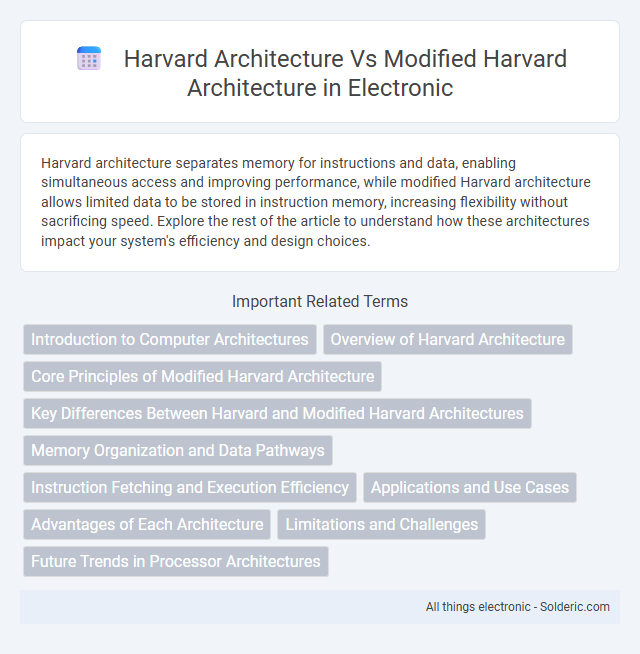Harvard architecture separates memory for instructions and data, enabling simultaneous access and improving performance, while modified Harvard architecture allows limited data to be stored in instruction memory, increasing flexibility without sacrificing speed. Explore the rest of the article to understand how these architectures impact your system's efficiency and design choices.
Comparison Table
| Feature | Harvard Architecture | Modified Harvard Architecture |
|---|---|---|
| Memory Separation | Strictly separate instruction and data memories | Separate caches for instructions and data; unified main memory |
| Data and Instruction Buses | Separate buses, allowing simultaneous access | Separate caches but shared bus for main memory access |
| Performance | High throughput due to parallel access | Improved performance with flexible memory usage and caching |
| Memory Flexibility | Fixed size for instruction and data memories | More flexible memory allocation via caching and unified memory |
| Complexity | Simpler control logic | More complex due to cache management |
| Use Cases | Embedded systems, digital signal processors | Modern microcontrollers, high-performance CPUs |
Introduction to Computer Architectures
Harvard architecture utilizes separate memory spaces and buses for instructions and data, enhancing parallelism and reducing bottlenecks in CPU design. Modified Harvard architecture combines features of both Harvard and von Neumann architectures by allowing shared access to instruction and data memories while maintaining separate caches to optimize performance and flexibility. This hybrid approach is commonly used in modern microcontrollers to balance speed and memory efficiency.
Overview of Harvard Architecture
Harvard architecture features separate memory spaces and buses for instructions and data, enabling simultaneous access and improving processing speed compared to von Neumann architecture. Modified Harvard architecture retains distinct instruction and data memories but allows some level of data transfer between them, enhancing flexibility while maintaining performance benefits. Your system's design choice between these architectures directly impacts memory access efficiency and overall computational throughput.
Core Principles of Modified Harvard Architecture
Modified Harvard architecture integrates separate memory spaces for instructions and data, similar to traditional Harvard architecture, but allows controlled data access to program memory for greater flexibility. It employs unified cache systems combining instruction and data caches to enhance performance while maintaining parallel access paths. This blend optimizes processing speed and efficient memory utilization, catering to complex computing tasks requiring simultaneous instruction and data handling.
Key Differences Between Harvard and Modified Harvard Architectures
Harvard architecture separates memory storage and signal pathways for instructions and data, enabling simultaneous access and reducing bottlenecks, while modified Harvard architecture combines some aspects by allowing shared or unified memory in specific cases, enhancing flexibility and reducing hardware complexity. Modified Harvard architecture typically merges instruction and data caches but maintains separate cache levels to preserve parallelism advantages. Key differences include strict separation of memories in Harvard architecture versus partial sharing in modified Harvard architecture, impacting system design, performance, and complexity trade-offs.
Memory Organization and Data Pathways
Harvard architecture features separate memory spaces and data pathways for instructions and data, allowing simultaneous access and increased processing speed. Modified Harvard architecture combines aspects of both Harvard and von Neumann architectures by using separate caches for instructions and data while sharing a unified main memory, optimizing memory organization for flexibility and performance. Your system's efficiency can benefit from the modified Harvard approach by reducing bottlenecks in data pathways without fully duplicating memory resources.
Instruction Fetching and Execution Efficiency
Harvard architecture separates instruction and data memory, allowing simultaneous instruction fetching and data access, which enhances execution efficiency by reducing bottlenecks. Modified Harvard architecture improves upon this by enabling a shared or unified cache, optimizing cache usage while maintaining some separation benefits, leading to more flexible instruction fetching strategies. Your system's choice between these architectures directly impacts processing speed and overall instruction throughput.
Applications and Use Cases
Harvard architecture is widely used in embedded systems and digital signal processing due to its separate memory pathways that enable simultaneous instruction and data access, optimizing speed and efficiency in microcontrollers and DSP chips. Modified Harvard architecture finds applications in modern CPUs and GPUs, balancing the advantages of Harvard architecture with flexible memory management, making it suitable for complex computing tasks like multimedia processing and real-time data analysis. Both architectures enhance performance, but modified Harvard architecture offers greater versatility for systems requiring dynamic memory usage and multitasking.
Advantages of Each Architecture
Harvard architecture offers faster data processing by using separate memory and buses for instructions and data, reducing bottlenecks and improving throughput for real-time applications. Modified Harvard architecture combines the benefits of Harvard with a unified memory space, enhancing flexibility and simplifying programming without sacrificing performance. Your system's design can leverage Harvard's efficiency or Modified Harvard's adaptability depending on specific application requirements.
Limitations and Challenges
Harvard architecture faces challenges in complexity and cost due to separate memory paths for instructions and data, leading to increased hardware requirements and potential underutilization of resources. Modified Harvard architecture attempts to mitigate these limitations by using a unified memory space for data while maintaining separate caches, but it may still encounter issues related to cache coherence and increased design complexity. Both architectures struggle with balancing speed and flexibility, where Harvard excels in parallelism but is less flexible, and Modified Harvard offers improved flexibility at the expense of some performance overhead.
Future Trends in Processor Architectures
Future trends in processor architectures emphasize the integration of modified Harvard architecture due to its enhanced efficiency in concurrent instruction and data access, crucial for high-performance computing and AI applications. Unlike the traditional Harvard architecture with strictly separated memory pathways, the modified version allows some shared memory spaces, enabling greater flexibility and faster processing speeds. Your computing systems will benefit from these advancements, particularly as chip designs push toward increased parallelism and reduced latency.
harvard architecture vs modified harvard architecture Infographic

 solderic.com
solderic.com